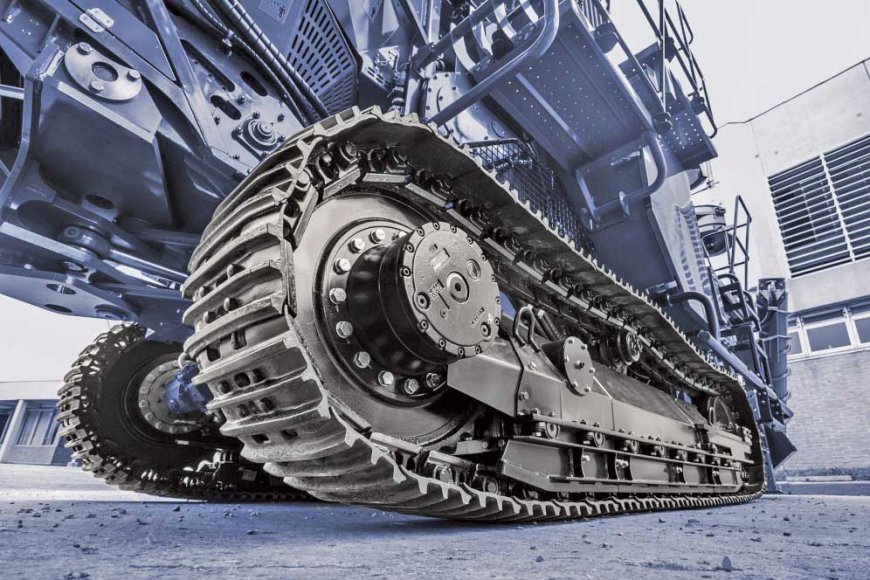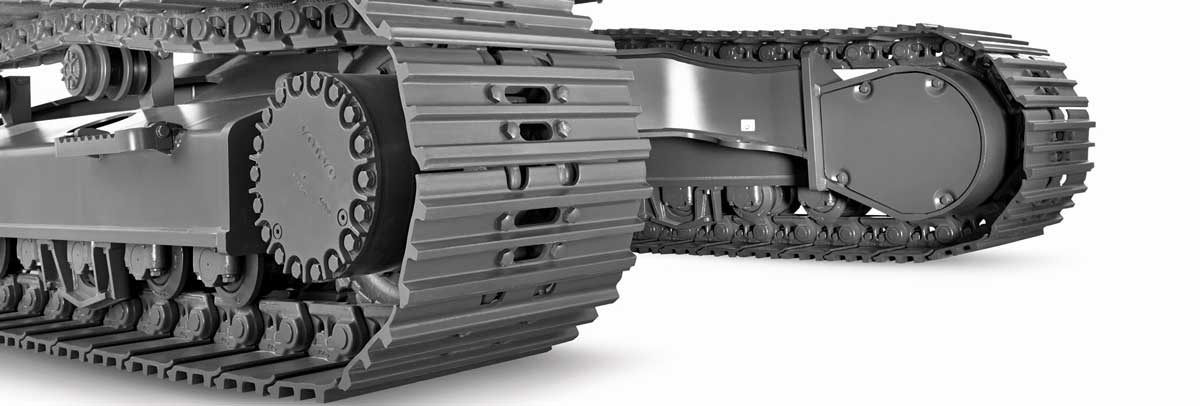TRACKING THE MOVE!
Rapid construction of road infrastructure across the world has boosted the demand for construction machineries, such as track loaders, bulldozers, and crawler dozers. Increase in incorporation of machineries in the mining sector, rise in use of small heavy duty machines

Rapid construction of road infrastructure across the world has boosted the demand for construction machineries, such as track loaders, bulldozers, and crawler dozers. Increase in incorporation of machineries in the mining sector, rise in use of small heavy duty machines in the industrial sector, and surge in construction activities is driving the market.
Equipment Times digs into the market trends, technologies and other aspects of the undercarriage parts used in construction equipment.
Earthmoving equipment, such as mining excavators, construction excavators and dozers, are heavy equipment that serve the primary as well as secondary sectors of an economy.
One of the vital parts of earthmoving equipment is undercarriage. Undercarriages consist of several components, including track shoes, final drive units, track rollers and other auxiliary components, to support the movement of earthmovers. Since the cost of new construction equipment is much higher than the cost of replacing existing components, operators tend to supplant earthmoving equipment undercarriage, bolstering the aftermarket trading of undercarriages.
Furthermore, an earthmoving equipment undercarriage represents a significant proportion of the equipment’s purchase price and upkeep and maintenance of undercarriages is not a short-term activity. Moreover, nearly half the overall maintenance cost of equipment can be attributed in its undercarriage. During operations, undercarriages experience wear due to rough terrains. For the proper operation of an equipment, maintenance plays a vital role, which subsequently creates an opportunity for aftermarket maintenance and repair activities. The demand for earthmoving equipment carriages can be correlated with the growth of end-use industries, such as construction, agriculture, and mining. Therefore, significant investment, government initiatives, and subsidies elevate the sales of earthmoving equipment undercarriages.
Know an undercarriage component…
The undercarriage is a part of a vehicle that lies beneath the main body of the vehicle. For various automobiles, undercarriages contrast along with their parts called as undercarriage components. Multiple undercarriage components such as track rollers, track chains, idlers and sprockets, track shoes, and bushings are employed across industries including mining, construction, and agriculture & forestry. They are utilized in undercarriages of earthmoving equipment such as crawler excavators, dozers, mini excavators, compact track loaders, and crawler cranes. Undercarriage further includes different systems and components, which are mounted beneath the carriage of heavy machinery, such as track loaders, bulldozers, and crawler dozers. Undercarriage components are caterpillar track chains, track shoes, idlers, drive sprockets, rollers, and carrier rollers. Several small components, such as links, pins, bushings, and frames, are likewise a part of the undercarriage.
Steady Growth…
Globally, the mining machinery and equipment market is being propelled by the prospect of an increase in the extraction activities for metals, such as copper and iron ore, and this is primarily being impelled by new production expansions and projects across the globe. Demand for metal mining equipment is foreseen to grow owing to gains in the sales of coal mining machinery, such as excavators, coupled with ongoing efforts to mechanize coal mining operations in some regions, says futuremarketinsights.com.
The construction industry across the globe is anticipated to present significant opportunities for construction equipment such as crawler excavators, dozers, compact track loaders, and crawler cranes. This in turn is expected to propel the usage of undercarriage components consequently driving their demand and sales. Moreover, growing commercial infrastructure is estimated to push Undercarriage Components’ Demand.
As per a report by verifiedmarketresearch.com, the growth in the agriculture and construction sectors is expected to propel the demand for heavy machinery. This, in turn, drives the demand for undercarriage components. Accelerated construction of road infrastructure across developing economies has hoisted the demand for construction machinery, such as track loaders, bulldozers, and crawler dozers. Rise in the incorporation of machinery in the agriculture segment, increase in the usage of small heavy-duty machines in the industrial sector, and surge in construction activities across the globe, drive the global heavy-duty machinery market. This, in turn, boosts the demand for undercarriage components. The availability of numerous machines that are driven on wheels and do not need tracks and undercarriage components is liable to inhibit the demand for undercarriage components.
However, the substantial initial price associated with construction equipment has triggered the trend of renting and leasing of construction equipment around the world. Mid and small-level construction players are experiencing high-cost burdens while purchasing new construction equipment. In a bid to satisfy their infrastructure requirements, they are opting for rental equipment to avoid high costs of new machinery. This is likely to negatively affect the sales of latest undercarriage components, owing to lowering demand for brand spanking new machines, successively restraining the expansion of the undercarriage components market.
Large infrastructure plans leading to high demand…
Governments across developing countries have enhanced investments in the field of infrastructure development such as roadways railways and other public developments. Rapid economic growth against the backdrop of large infrastructure gap has proliferated healthy prospects for the construction industry. Consequently, growth in the utilization of construction equipment will likely underpin the demand for replacement of earthmoving equipment undercarriages.
Back to pavilion after the Covid-19 outbreak…
The Covid-19 outbreak had a negative impact on the global undercarriage components market last year due to the closure of manufacturing plants in various countries. Moreover, this had also impacted the demand for construction equipment, significantly, which had resulted in a drop in demand for undercarriage components in the near-term forecast.
However, manufacturers are optimistic that recovery in demand for construction equipment such as crawler excavators, dozers, compact track loaders, and crawler cranes is anticipated to trigger the use of undercarriage components, consequently leading to the expansion of the undercarriage components market size in the years ahead.
Commercial infrastructure is expected to witness significant growth on the back of increasing infrastructure activities and urbanization. Rising construction projects such as expansion of airports, construction of commercial buildings, growing highway constructions, road extensions, and residential projects have further pushed the demand for heavy machinery, in turn, reinforcing the demand for undercarriage components.
According to factmr.com report analyst, rising demand for undercarriage components in the construction and mining industry has influenced manufacturers to develop advanced products. Technological advances in the manufacturing and design of undercarriage components have enhanced their durability and efficiency.
However, this has resulted in an increase in the pricing of undercarriage components, along with high maintenance costs. Against this backdrop, the prevalence of counterfeit undercarriage components has significantly risen, in turn, challenging the growth of the market. Low pricing of counterfeit undercarriage components has resulted in a substantial surge in their sales.
However, quality concerns associated with counterfeit undercarriage components remain questionable in terms of future adoption. This factor is likely to confine the sales of original undercarriage components, in turn, posing challenges to OEMs and genuine retailers of in the coming years.
Crawler excavators dominating undercarriage segment…
Undercarriage components for crawler excavators are foreseen to dominate the equipment segment and rising focus on the development of high value service industries coupled with increasing pace of economic diversification has presented potential opportunities for earth moving equipment such as crawler excavators.
These are increasingly being used for digging land and clearing rocks and sand on construction sites. Crawler excavators are utilized for attempting highly complex construction operations, owing to which, the utilization of undercarriage component by crawler excavators is foreseen to maintain its dominance.
Track basics
Most crawler dozers leave the factory with SALT (sealed and lubricated track) chains, which use pins having an internal reservoir of oil that flows through a radial hole in the pin and into the annular space between the pin and bushing. Seals in the link counterbores (into which the bushing ends seat) retain the oil. As long as seals remain effective, the oil retards internal wear between the pin and bushing as the pin rotates within the bushing during normal operation.
Most hydraulic excavators come from the factory with ‘greased’ chains, which are assembled with heavy grease between the pin and bushing.
Pin and bushing wear
When pins and bushings wear internally due to lack of lubrication, wear occurs primarily on one side of the pin and on the mating surface of the bushing’s inner diameter. Wear changes the geometry of the track by allowing track pitch (the distance between pin centers) to extend, resulting in a “stretched” chain that runs loose.
Normal wear on the outside of the bushing also occurs primarily on one side, the reverse-drive side, because the bushing rotates under considerable load at the top of the sprocket when the machine reverses. Although the bushing rotates at the same spot during forward travel, the load in minimal.
This primarily one-sided wear of pins and bushings allows these parts to be “turned”—bushings rotated 180 degrees and pins flipped end-for-end-to bring new surfaces to working areas,
both internally and externally. Turning restores track pitch and can prolong undercarriage life by enabling the chain to last until links and rollers need attention.
Turns on today’s machines with lubricated tracks can be either wet or greased. During a wet turn, the pins are refilled with oil, a process that involves pulling a vacuum in the pin’s oil reservoir (through a self-sealing plug in the end of the pin) and drawing in new oil. If the assembly won’t pull a vacuum, chances are that the seals will leak. With a grease turn, pins and bushings are simply reassembled with heavy grease.
Although turning pins and bushings has been somewhat of a maintenance staple in the past, the economic value of the practice is getting a harder look today.

Hits: 2








